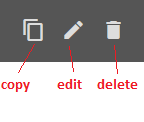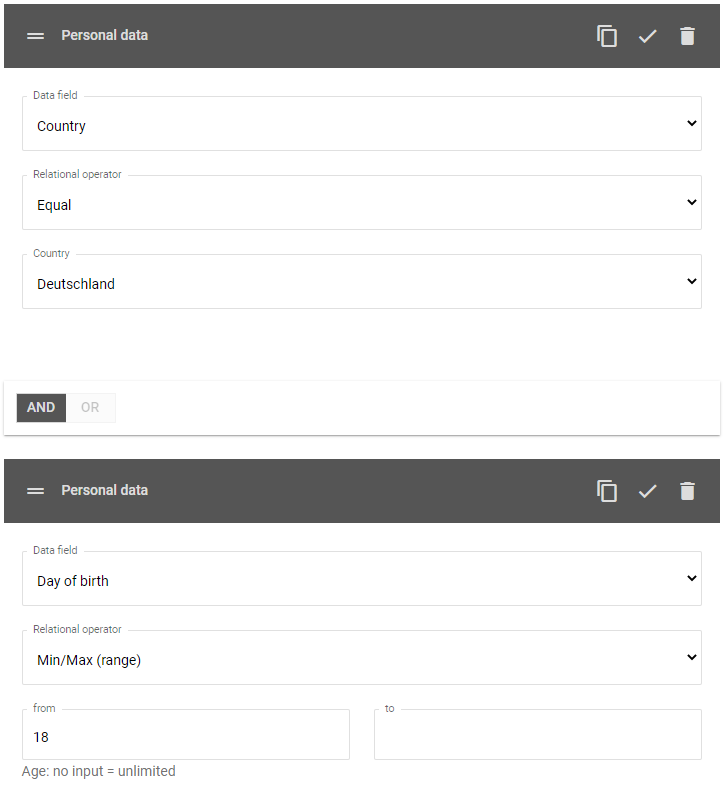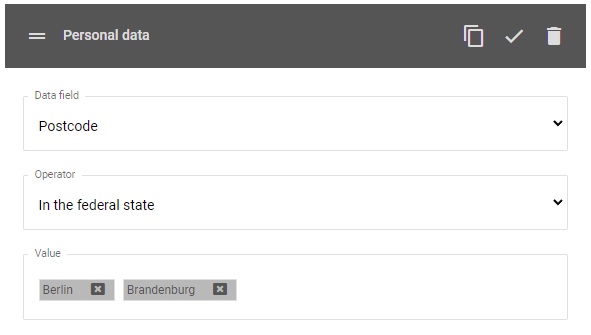Table of Contents
How do I create a filter?
You can apply predefined filters when assigning a target group to an email or when using the target group function filter.
This entry explains how to define and save filters.
Filters can be used in standard campaigns as well as in the workflow of auto campaigns.
In auto campaigns, the usage is not part of promio.connect by default. If interested, please contact our support team via ticket.
Create and name a filter and directory
Go to filter management via Addresses > Filter.
Use these buttons to create a new filter or a folder at the top level.

Create directory
Using the FAB action Create directory (in top level), you can create folders at the top level and name them.
You can create new subfolders using the three dots to the right of each folder in the filter tree.
Create filter
Here you can name new filters, save them in a folder or subfolder, and specify the conditions. Subfolders are displayed in the selection menu with their corresponding parent folders: FOLDER NAME / SUBFOLDER NAME.
Defining conditions
Compose your filter by combining one or more conditions. The following types of conditions are available:
| type of operator | Description |
|---|---|
| BLOCK | Create a new bracketed block to control the AND/OR sequences. |
| Personal data | Filter by master data content. Typical cases: Men, zip code areas, Germany 18+, addresses associated with the domain @web.de, etc. |
| Auto Target Group | Filter by a user’s inclusion/non-inclusion in an existing auto target group. |
| Last opened | Filter by when your users last opened an email. Typical case: No opens in the last x days |
| Last clicked | Filter by when your users last clicked a link in your email. |
| Last addressed | Filter by when or whether an address was contacted. |
| Bounced | Filter by when or whether an address created a bounce. |
| Activity Score | Filter by opening and click rates. additional feature |
| E-Mail: Recipients | Filter the recipients of a specific email. |
| E-Mail: Open | Filter by whether a specific email was opened. |
| E-Mail: Click | Filter by whether a user clicked in a specific email. |
| E-Mail: Click on the specific link | Filter by whether a user clicked a specific link in a particular email. |
| E-Mail: Conversion | Filter by whether a particular email triggered a conversion. Typical case: Non-subscriber of an email. |
| E-Mail: Bounce | Filter by whether a particular email generated a bounce. |
| Profiler | Filter by whether the user is associated with a specific profile. The profiles can come from click profiles, the Profiler360, or a stored Profiler questionnaire. additional feature |
- Fill in the necessary details, e.g. select an email, choose the operator, or specify a value or list.
Do you want to filter by federal state? Select type personal data, data field postcode and as operator “In the federal state” or “Not in the federal state”.
The condition type Personal data gives you the option of filtering by several values. Choose the operator In the list to do so. Enter the values separated by a comma, e.g. “Munich,Cologne,Hamburg”.
The condition type Personal data also allows you to search for strings by using wildcards in combination with the operators Equal and Unequal. Use * or ? as follows:
- Example 1: *@promio.net returns all email addresses that end in @promio.net.
- Example 2: *gmx* returns all addresses that contain the term 'gmx'.
- Example 3: 531?4 returns all conforming zip codes like 53104, 53114, 53124 etc.
The type Profiler is only available if this feature is activated in your client. If interested, please contact our support team via ticket.
Link conditions and set brackets
Multiple conditions can be combined with an AND or OR link. By default, two conditions are linked with AND. The active link is marked with a dark background.
An AND link means that in order to be selected by the filter, data records must meet BOTH conditions. Example: male AND over 20 years old.
An OR link means that in order to be selected by the filter, data records can ONLY meet ONE of the linked conditions. Example: female OR subscriber of email “2016-01-20 Shoes Available Free of Charge”
To define more complex filters, you can set bracket blocks to selectively control the AND / OR links. Select BLOCK as the condition type to create a bracket block.
Brackets affect your filter’s logic!
Example: Condition 1: male | Condition 2: First name equals “Andrea” | Condition 3: female
Condition 1 AND Condition 2 OR Condition 3 - Conditions 1 and 2 must be met, OR condition 3 must be met.
Result: all men named Andrea, as well as all women
vs.
Condition 1 AND (Condition 2 OR Condition 3) - Condition 1 must be met, AND one of the conditions 2 and 3 must be met.
Result: all men named Andrea
Save filter
When you have finally edited all conditions, save the filter with  .
.
Only fully defined filters can be saved. A condition that contains errors will be highlighted in red. Correct or complete the highlighted condition and click OK again in order to validate and save the filter.
Further options
On the upper right of each filter condition you can edit these:

With the first symbol you can copy a condition. The copy will be inserted beneath copied one.
Via the check mark you can close or collapse a condition and its parameters.
By clicking the bin sign you delete a condition.
If you want to alter the order of conditions you can switch them by drag&drop.
Closed conditions ensure a better overview, especially in the case of complex filters. If a condition’s definition contains errors, the condition cannot be closed and is highlighted in red.
You can delete a filter using the trash can icon in the top right corner:

Avoid deleting filters that are in use in campaigns.
Copy filter
You can copy an existing filter by exporting the original filter and then importing it again when creating a new filter. Such an import is also possible in another client.
- Copy the displayed code of the filter into the clipboard by clicking in the text field.
- Navigate to Addresses > Filter and use action Create filter.
- Now filter conditions of the original filter are visible and you can edit and save the filter.











